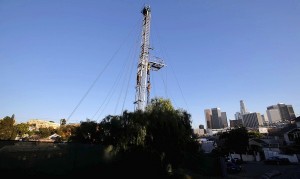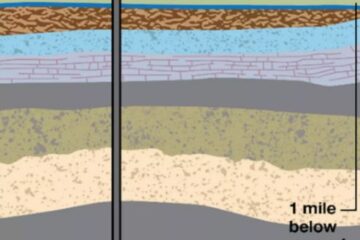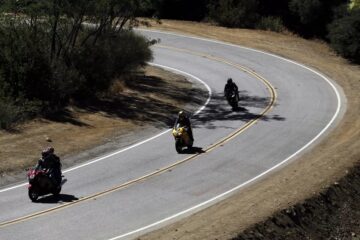Capping an era of L.A. oil exploration
Long-abandoned wells on the Los Angeles City Oil Field, which sparked Southern California’s oil boom 120 years ago, are being sealed to make way for a 45-unit affordable housing project.
Source of this article: The Los Angeles Times, January 9, 2012
It almost seemed as though oil drilling rigs were ready to tap into Los Angeles’ first petroleum field again.

Henry Ortega works to seal an old oil well near the corner of Glendale Boulevard and Rockwood Street. Long-abandoned wells on the Los Angeles City Oil Field, which sparked Southern California’s oil boom 120 years ago, are being capped to make way for a 45-unit affordable housing project. (Francine Orr, Los Angeles Times / December 28, 2011)
But the workers setting up a pair of derricks south of Echo Park last week were plugging some of the city’s oldest wells — not drilling new ones.
The sealing of the long-abandoned wells by Allenco Energy to make way for a 45-unit affordable housing project marks the end of an era for the Los Angeles City Oil Field, which sparked Southern California’s oil boom 120 years ago.
The city’s first commercially successful oil well was drilled about 350 feet away, at the corner of Glendale Boulevard and Rockwood Street.
In 1892, pioneering oil wildcatter Edward L. Doheny and partner Charles A. Canfield used picks and shovels and, finally, a sharpened 60-foot-long eucalyptus tree trunk to drill about 200 feet down near the corner of Glendale Boulevard and Colton Street.
At first, their shallow well produced less than 10 gallons of thick, fuel-grade oil a day. But that was enough to begin the stampede for black gold that quickly spread across the Los Angeles Basin and beyond, and made Doheny a rich man.
Soon, drillers were sinking their pumping pipes as deep as 900 feet. When oil at that level started to run out, they bore down to 1,200 feet, then 1,500 feet. Most Los Angeles oil was found no deeper than that.
Four and sometimes five wells were drilled on small residential lots along a narrow swath that extended the Los Angeles City Oil Field about 31/2 miles from the Chinatown area south of Dodger Stadium west to Berendo Street. Tent cities sprang up to house bootleggers and prostitutes who streamed in behind the growing horde of oil drillers.
Modern oil field maps on file with the state’s Division of Oil, Gas & Geothermal Resources show that about 1,250 wells were drilled into the field before it was sucked dry. When that happened, drillers and speculators moved on to untouched reservoirs in hilly areas in Long Beach, Santa Fe Springs, Inglewood and Torrance.
One of the first eager young oil hunters to join the Doheny rush was Edward A. Clampitt, who had arrived in Los Angeles in 1888. He is listed in state records as the operator responsible for the five wells at the corner of Glendale Boulevard and Rockwood Street.
Although state oil well records are sketchy before 1915, Clampitt’s wells are believed to have been sunk before 1900. Later he would own oil-producing land in the Newhall Pass area and serve on the Los Angeles City Council.
Petroleum geologist Dale Kunitomi, who has studied Southern California oil fields since 1967, is among those who are convinced that Clampitt and his colorful family were the inspiration for the Clampett clan in the CBS TV series “The Beverly Hillbillies.” It ran from 1962 to 1971 and starred Buddy Ebsen as family patriarch Jed Clampett.
“I went to Belmont High School in the early 1960s, and you would see Clampitt Oil Co. signs on oil field installations up there,” Kunitomi said. “I said to myself: So the ‘Beverly Hillbillies’ are real!”
Kunitomi said early well-plugging was often a casual procedure. “They’d take rocks and debris and toss it down the hole. But pressure can build up and water can seep beneath the oil and push it up,” and methane gas can leach out of the ground, he said.
The potential threat from seeping methane and hydrogen sulfide prompted Los Angeles school officials to halt construction of the half-built Belmont Learning Complex in 2000. Finishing the project, now called the Roybal Learning Center, at the edge of the Los Angeles City Oil Field doubled the final cost to more than $400 million.
Don Drysdale, a spokesman with the Division of Oil, Gas & Geothermal Resources, confirmed that such things as old telephone poles were used as oil well plugs before rules were tightened in the 1970s.
These days, rules spell out the type of casing and amount of concrete plugging that has to be done and specify that a “diligent effort shall be made to recover junk” from abandoned wells.
The city has issued a demolition permit for the restaurant, butcher shop and office building that operated near the old wells until recently, and awarded a grading permit to allow plugging to begin, said David Lara, a spokesman for the Los Angeles Department of Building and Safety. Although abandoned wells fall under the jurisdiction of the state, the city also has rules about escaping methane gas.
The affordable apartments will be developed in conjunction with the Filipino Workers Center by LTSC Community Development Corp., operated by the Little Tokyo Service Center. Construction on the $20.5-million project will start in April and take about 18 months, said Takao Suzuki, director of real estate development for the service center.
Because there may be seven abandoned oil wells on the site instead of the five shown on state records, his organization has allocated $1 million for plugging costs, he said.


